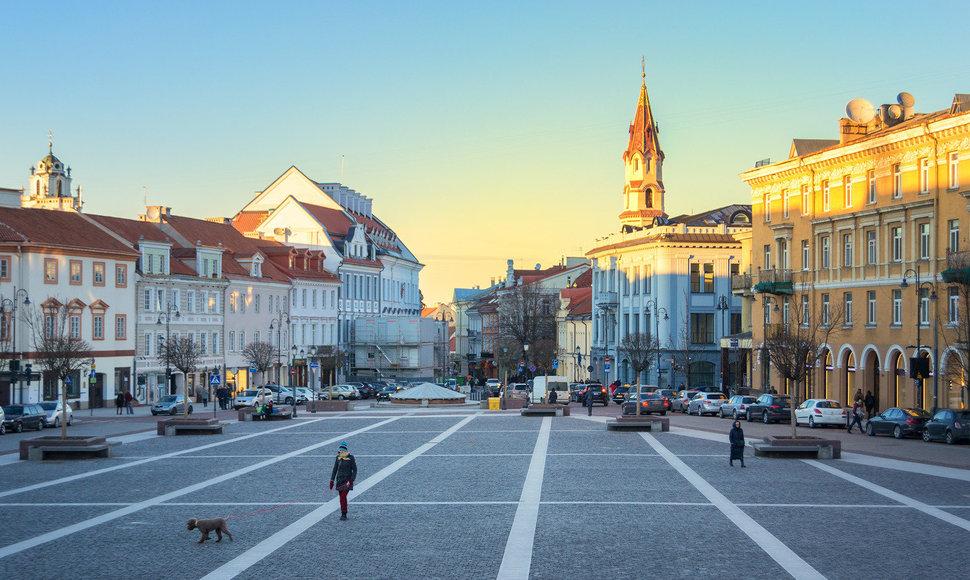These results were revealed in a survey by market and public opinion research company Spinter Tyrimai which was performed on commission for Darnaus Miesto Laboratorija [Harmonious City Lab], which was in turn created by Darnu Group to bring together competences for creating a harmonious environment. The survey sought to uncover Vilnius residents’ views of their own residential districts.
Experts note that the poorer rated, so-called ‘sleeping districts’ of the capital could be re-awakened and enlivened by functional development, and together with solutions that inspire communality, these factors would become a basis for improving local residents’ sense of wellbeing.
“People no longer find the old distinction of zones for work or living, or seeking cultural life acceptable. The survey’s data shows that the Vilnius residents who are most content are those living in versatile districts, which combine quality public spaces, natural environments, good transportation links, plentiful service offerings and opportunities to satisfy cultural needs and socialise without venturing far from home,” states Mantas Umbrasas, property management director for Darnu Group, the founder of Darnaus Miesto Laboratorija.
More centres of gravity
Overall, Vilnius residents are quite happy with their home districts – based on various criteria on a ten-point scale, the capital’s combined average reached 7.96 points. The most modest average scores were granted to Šeškinė by its residents with 7.38 points, Pilaitė with 7.42 points, and Vilkpėdė with 7.52 points.
Meanwhile, according to the survey, those most content with their home district were those living in Senamiestis (9.19 points), Žirmūnai (8.51 points) and Naujamiestis (8.47 points).
According to urbanists, the capital’s sleeping districts could be awakened, almost literally, by creating factors that ensure more liveliness. Some of them are related to functional development, others, promotion of communality.
According to architect urbanist Martynas Marozas, sleeping districts are home to around 50 per cent of the city’s residents and to raise their contentment, conditions firstly need to be ensured not only for sleeping, but also living a wholesome life.
“Efforts are made to provide for a variety of functions in modern city districts because the more variety, the more so-called ‘centres of gravity’ form: cafes, offices, stores, cultural centres or other services. This must absolutely be done so that the territories would be lively around the clock, and not just for part of the day. At the same time, infrastructure challenges are resolved, reducing the need for car travel, and parking space occupancy is optimised, leading to generally increased living satisfaction in a district,” M. Marozas states.
Successful examples
Architecture and urbanistic innovator Donatas Baltrušaitis says that good experience does not need to be sought very far away – it suffices that we look at what works already.
“In order to improve the lowest-rated residential district aspects, we can follow the example of Senamiestis, which has the highest rating, with more distribution of cultural infrastructure and entertainment offerings, planning not only public spaces but also real estate projects,” D. Baltrušaitis proposes.
M. Marozas notes that the capital’s ‘sleeping districts’ have already reached a significant building density, but at the same time, there are still numerous spaces which are little made use of and could offer new value.
“Such districts must be supplemented with the functions they are lacking, and their communities could indicate what they feel is lacking. Furthermore, more time is spent in the districts, which create a mixed service environment, and allows for various groups to fulfil their needs. Their infrastructure is also used more effectively, and so this is something everyone should be interested in,” the specialist notes.
Darnu Group property management director Mantas Umbrasas points out that in order to embrace the concept of multifunctionality, Vilnius’ main real estate developers are not undertaking individual building development projects, and are instead developing entire districts so that they can attract numerous different businesses, service providers, art and culture figures, and at the same time meet the needs of contemporary city residents.
“People greatly value their time, and have expectations for their living environment that relate to it. In part, this has already been adjusted by the pandemic’s influence where the need for active life near the home has grown even further,” M. Umbrasas observes.
The role of community for a sense of wellbeing
In terms of cultural and recreational spaces, urbanists emphasise the importance of communality and the need to create centres of gravity, which would inspire people to nurture them themselves.
“I believe that feelings of communality, socialisation, and integration in society are crucial for people’s wellbeing in their living environment. As such, these are aspects that are truly important to encourage in residential districts. A good primary boost could be certain areas intended for communities, but this doesn’t necessarily have to be buildings – it could be pavilions, resting areas or active leisure zones with exercise equipment, or even a small library. What is most important is to discern the needs of every individual community and find out what they specifically need,” D. Baltrušaitis says.
According to the specialist, when resolving the lack of cultural infrastructure, one shouldn’t think only of monuments and sculptures. This also includes various architectural interventions and other solutions, which could also encourage communality.
“This could be even setting up a city garden or multifunctional pavilions, which would satisfy the needs of communities, and would allow for various activities,” the urbanist notes.
According to M. Marozas, most such solutions do not demand much investment.
“This is because the most valuable moments are simple and pleasant traditions or initiatives, which show that people are cared for. For example, this could be a book-sharing stand or similar small initiatives, which show that a creative and harmonious community resides in the district,” M. Marozas states.
The Spinter Tyrimai survey consulted 1,006 residents of Vilnius on their satisfaction with their home districts.












